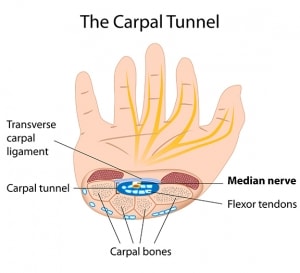 Do you have a pain or numbness in your hand that has been there for months and won’t go away? If you do, don’t pass this off as a passing cramp or regular pain. This pain can be the result of carpal tunnel syndrome.
Do you have a pain or numbness in your hand that has been there for months and won’t go away? If you do, don’t pass this off as a passing cramp or regular pain. This pain can be the result of carpal tunnel syndrome.
Carpal tunnel syndrome is the result of an entrapped nerve in the wrist and can limit mobility and cause muscle weakness, numbness and tingling in the hand. Carpal tunnel syndrome is a progressive condition that can be treated with stretching exercises, corticosteroid injections, splinting or surgery that involves cutting the carpal ligament to reduce pressure.
What is carpal tunnel syndrome?
Carpal tunnel syndrome is a hand and arm condition that causes numbness, pain and tingling. Carpal tunnel syndrome is caused when the median nerve, which is the nerve that stretches from the hand to the forearm, becomes pressed or squeezed at the wrist.
The carpal tunnel is a narrow passageway that houses the median nerve and tendons. Sometimes, the surrounding tendons become thickened or swollen and in turn narrows the carpal tunnel and compresses the median nerve.
Carpal tunnel syndrome is more common among women than men. It is also more common in people who have nerve-damaging conditions such as diabetes. Women who are pregnant may also experience carpal tunnel syndrome, but it will generally resolve after pregnancy.
What are the symptoms of carpal tunnel syndrome?
Carpal tunnel syndrome is a progressive condition and the symptoms usually start gradually. It typically begins with numbness or tingling in the thumb, index and middle fingers that comes and goes.
Symptoms of carpal tunnel syndrome include:
- Tingling or numbness that may extend from the wrist up the arm
- Pain
- Burning
- Weakness in the hand
- Feeling as if the fingers are swollen
How is carpal tunnel syndrome diagnosed?
 While carpal tunnel syndrome is the most common cause of numbness in the hand it’s not the only cause. The numbness may be caused by a herniated disc in the neck, various spinal issues and diabetic neuropathy.
While carpal tunnel syndrome is the most common cause of numbness in the hand it’s not the only cause. The numbness may be caused by a herniated disc in the neck, various spinal issues and diabetic neuropathy.
If a patient is experiencing frequent numbness in the hand, they should visit their physician. From there, their physician will conduct a physical exam of the hands, arms, shoulders and neck to see what is causing the tingling and numbness.
What nonsurgical treatment options exist for carpal tunnel syndrome?
Treating carpal tunnel syndrome should begin as soon as possible. Initial treatment will likely include resting the affected hand for at least two weeks and immobilizing it with a splint. If the pressure to the median nerve is caused by swelling, a patient can apply cool packs to reduce the swelling. Corticosteroid injections may also alleviate the pain, swelling and inflammation of carpal tunnel syndrome.
What surgical treatment options exist for carpal tunnel syndrome?
When the symptoms of carpal tunnel syndrome persist for at least six months after trying nonsurgical treatments, a physician may suggest surgery. With carpal tunnel surgery, the goal is to relieve the pressure on the median nerve by cutting the ligament pressing on the nerve.
Endoscopic surgery typically has a faster recovery time than open release surgery. Two incisions are made in the wrist and the palm and using an endoscope, a tiny, telescope-like instrument, the surgeon cuts the carpal tunnel ligament.
What happens after surgery for carpal tunnel syndrome?
After carpal tunnel surgery, the ligament tissues grow back together gradually, but allow more room for the median nerve. Recovery from carpal tunnel surgery may take a few months and patients should undergo physical therapy to regain wrist strength during this time.
Patients are encouraged to start moving their hand after surgery and will gradually be able to perform normal activities. Most patients report that they feel relief from numbness the day of the surgery. After surgery, carpal tunnel syndrome rarely reoccurs.



